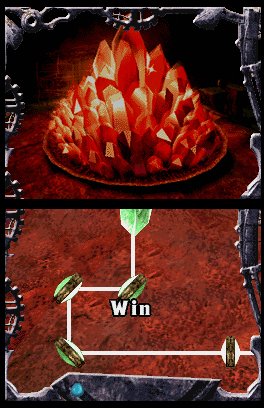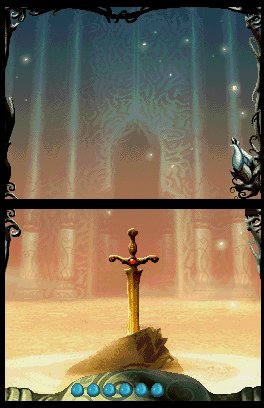To be clear from the get-go, Arthur and the Invisibles on the Nintendo DS isn't for everyone. The frenetic pace of this minigame collection and the necessity for you to actually exercise your brain to figure out what's going on may be off-putting to some. But, if you count yourself a fan of the WarioWare series of games or are just interested in an alternative style of gameplay, there is a lot to like about Arthur on the DS.

In spite of its format, Arthur and the Invisibles still imparts a bit of a story, namely by way of a few cinematics at the end of each level set. By no means will you get a comprehensive overview of the movie it's based on, but you will glean a few bits and pieces that describe each of the three main players, Arthur, Selenia, and Betamech, as well as an extremely loose rundown of the movie's plot. To keep it as brief as the game does, Arthur, Selenia, and Betamech set out from the Minimoy village to Necropolis to attempt to save Arthur's grandma's house from foreclosure and the microscopic civilization residing in his backyard from the evil henchmen living in his basement. Along the way, Arthur rescues his grandpa, scores some crazy-hot rubies, and puts the moves on a 900-year-old princess. While all of this is nice to know, it's completely ancillary to the meat of the game, and if this is your only introduction to the world of the Minimoys, then just ignore it altogether and feel comfortable in the knowledge that you're really not missing much.
Like in the WarioWare games, you'll be presented with a quick succession of minigames that culminate in a boss stage. The format is also similar in that you'll be given a countdown timer that lasts anywhere from 5 to 20 seconds, and you'll need to finish your task within that time frame. There are 12 levels in all, subdivided into three sets, and levels get progressively longer and more difficult, with the first two containing 10 and 20 minigames, respectively, and the final throwing a total of 40 at you. Many of the minigames follow a rapid-fire format, whereby on first encountering them, you've typically lost before you realize what you're even supposed to do. However, many others, especially in the latter levels, test your memory, coordination, and critical analysis skills, rather than just your twitch-reaction speed. This is a departure from the WarioWare formula, and the added complexity helps to alleviate one of the primary issues that plagued WarioWare: Touched!, that being the repetitive and somewhat limited use of the stylus. Since solving the puzzles becomes your focus, you'll be more interested in what's happening on the screen than what you're doing with the stylus. This isn't to say that your actions won't become quite repetitive after a while, as you're still limited to the same tapping, circling, scratching, slashing, and guiding, as well as some blowing into the DS's microphone. Puzzle-solving does go a long way in sustaining your interest in the game, though. It also helps that the game unfurls the 90-plus minigames at a measured pace, so you'll still run up against things that make you go "hmm..." in the latter levels.
The game also packs in some extras. A few of the minigames aren't conceivably doable in the time frame you're allotted until you've committed them to memory--a particularly vicious mirror game comes immediately to mind--which is why it's nice that a training mode is included in the package. Here, you'll have access to all of the minigames that have already been thrown at you, so you'll be able to practice before you head back into the story mode. Your other option is a mul-mul rearing mode, which is essentially a Tamagotchi knockoff. Your enjoyment of this mode hinges entirely upon how cute you find mul-muls, because there really isn't much depth here--there isn't much to do other than pet your mul-mul and, when appropriate, clean up its poo. If you can find someone else with an Arthur and the Invisibles cart, you'll be able to have the two pets visit, but as you're essentially just looking at dandelion fluff with eyes and arms, there really isn't much appeal here. Also, if neglecting your adorable little mul-mul and leaving it to wallow in its own by-products would keep you awake at night in mental anguish, you have the option to pause the mode, which really is a thoughtful touch.
Arthur and the Invisibles looks pretty good. There is a good deal of variety in the backgrounds for the various minigames, and all of the colors are vibrant and engaging. You'll also see a pretty good variety of objects on the screen, which typically are noteworthy elements of the movie, though some of them probably aren't as detailed as they could be. As for the sound, nearly every action has a distinct ring or noise to accompany it, which means you won't go batty hearing the same buzzer over and over. The music isn't exceptional in any way, but it does do a good job of segueing between minigames.

What you will find with Arthur and the Invisibles on the DS is a mostly enjoyable collection of fast-paced minigames that will keep you on your toes and offer a play experience that's comparable to the WarioWare series, if not quite as enjoyable. Once you've worked your way through all 12 levels, which could take anywhere from four to eight hours, you won't find much to keep you playing. But while it lasts, it's a good bit of fun.